Abstract
Management of change is important to accomplish a successful transformation plan to the learning organizations as they are facing radical changes in the environment. There are many researches that studied management of change and specifically the attitude of people toward the change. This research included the examination of management change approach used by M-Company to deal with their transformational change plan “Tahawul”, and to engage people in M-Company towards this change. In the research analysis, the survey results discuss the main questions regarding employee’s awareness and readiness towards this change to approve that M-Company adopted the right approaches through this transformational change process.
Introduction
In the business world, transformational change involves a company making a radical change in its business model, often requiring changes in company structure, culture, and management. Companies may undergo a transformational change in response to the crisis, or in order to reposition themselves in the market. The transformational change also occurs in response to changes in technology, or as companies adapt to take advantage of new business models.
And this is exactly the case with “M-Company”. M-Company is a trading name launched in May. The GSM Associations “GSM Association Newsletter” Dec. 2004 edition described M-Company as the fastest growing mobile operator in the Middle East & North Africa. The growth success story continued during 2006, when M-Company reached more than 4,800,000 subscribers and as of 20 January 2007, M-Company had 6 million subscribers and 0.5 million 3G users.
Very concerned of maximizing their revenues and considering the expected decrease in consumers’ attraction to voice mobile services, M-Company decided to consider new business opportunities expanding its customers to include cloud services and information technology solutions, transforming from a telecom company into an information and communication technology company (ICT) in 2013.
For any management of change project to be successful, three conditions must be met; the sense of need for change, a clear vision of where the organization should be heading as per the management of change project model and finally a process that enables the change. Any weak link in this chain can compromise the management of the change project. So, did M-Company’s transformation, Tahawul, satisfy all the management of change conditions?
Problem Statement
The lack of research on the impact of not focusing on creating the need for change and developing the sense of dissatisfaction of the status quo on the success of the management of change such as managing Tahawul. This research will focus on this area to reduce the gap and form the best practices accordingly.
Research Significance
This research is a reference gathering best practices to develop the need for change in transformation projects such as Tahawul.
Research Objective
This research aims to study in detail how dissatisfaction can be developed to enhance the change result. This would be done through:
- Examine the relationship between employees’ involvement and the level of dissatisfaction and how this affects the successful transformation.
- Examine the relationship between communication and the level of dissatisfaction and how this affects the successful transformation.
- Examine the relationship between confidence in top management and the level of dissatisfaction and how this affects the successful transformation.
Literature Review
Introduction
This chapter reviews previous literature related to change management and resistance to change for the purpose of obtaining a more profound understanding of key concepts and models of organizational change and resistance to change.
This chapter includes four sections. Section 6.2 is about organizational transformation definitions and some practices that lead it to be successful. Section 6.3 presents organizational change management and reviews literature regarding organizational change concepts and models. Section 6.4 discusses employee attitude toward change. Whereas, section 6.5 reviews employee’s resistance toward change.
Organizational transformation
Transformation (in an organizational context), is a process of profound and radical change that orients an organization in a new direction and takes it to an entirely different level of effectiveness (Business Dictionary, n.d.).
Organizational transformation takes place when there is a change in the way the business is done or in the event of a reengineering and restructuring activity, so it is a substantially changing an organization’s structure and practices (Wanda J. Orlikowski, 1995)
Leading the transformation to performance excellence from the top is complex and, based on extensive experience; it appears to include numerous concepts from a large number of theories (John R. Latham 2013). Burns (1978) introduced the concept of (Transformational leadership) and highlighted the difference between (Transactional Leadership) and (Transformational Leadership initially).
Later Burns (2010) referred to transformational leadership as a leadership style that is represented by traits like charisma in addition to the shared vision between leaders and followers. According to Bass’ (1985) the model of Transformational Leadership, is regarded as the most suitable leadership style by the theorists and researchers for the organizations which truly want to encourage their employees to perform beyond expectations and transform their selves into ultimate binding force. Bass (1985) further reported that transformational leaders motivate followers to achieve performance. (Kazmi, Naaranoja, Takala, 2013)
A transformation program provides the opportunity to transform organizations from being reactive to proactive. (Ron Higgins, 2010). It is estimated that somewhere between 70% and 80% of the attempts at organizational transformation fail (Miller 2002).
But we can learn from those who have led successful organization transformations and achieved performance excellence, John P. Kotter (1997) describes a series of phases that everyone has to go through to transform their organization successfully: establishing a sense of urgency, forming a powerful guiding coalition, creating a vision, communicating the vision, empowering others to act on the vision, planning for and creating short-term wins, consolidating improvements and producing still more change and institutionalizing new approaches.
McKinsey also (2008) highlight several important tactics that organizations use to transform themselves successfully, Setting clear and high aspirations for change is the most significant, engaging the whole company in the change effort, and communicate the need for change in a positive way encouraging employees to build on success rather than focusing exclusively on fixing problems.
Employees’ resistance to change
Speaking about the employees’ resistance to change, it should be noted that the scope of the problem is not as significant as it might seem at first sight. Thus, for instance, Bradutanu (2015) refers to the recent research that showed that only 30% of employees oppose strongly to the transformations, whereas the major part of the workforce is commonly neutral about them (p. 28). In the meantime, these findings should not be regarded as a positive sign. A successful transformation requires employees’ willingness and readiness to accept it – thus, the neutral attitude does not assist considerably in performing a change. However, the neutral attitude is evidently less problematic to turn into a positive one than a strongly pronounced resistance.
Experts agree upon the fact that the employees’ resistance to change has a complicated nature. Raoprasert and Islam (2010) note that employees mainly resist not the change itself but the fact of “being changed” (p.28). Otherwise stated, employees do not commonly resist the changes until the latter concern their own activity and individual behavior. Thus, for instance, technical implementations are accepted more willingly than social changes as they do not have a powerful impact on an employee’s personality.
Raoprasert and Islam (2010) also point out that employee’s resistance to change is likely to have a negative influence on change implementation. Thus, it is important that employees participate actively in the process of change, share their vision of the desired outcomes, and point out the existing flaws. In case they oppose the proposed transformation, managers will have to act without their advice and recommendations, in this case, they are more likely to overlook potential risks.
The employees’ resistance to change can be expressed in various forms. Thus, for instance, Bradutanu (2015) suggests distinguishing the four main types of resistance: direct, immediate, implicit and deferred (p. 28). The first two types are easier to indicate and thus, less problematic to handle. Those employees that express their resistance in the direct or immediate form are likely to complain to the management and organize protests. The latter two types are more dangerous as they are harder to recognize and thus, more difficult to manage. It is assumed that the employees that express their resistance in an implicit or deferred form are more likely to be absent from work, appear to be less motivated, and show lower performance productivity.
According to Bradutanu (2015), there are six common ways in which employees’ resistance is apt to be expressed: denying the need for transformations, showing indifference, demonstrating incompetence, postponing the task completion in order to impede the change process, expressing impatience, and being cautious (p.29). As it might be seen, all the types of expression are evidently negative for the general quality of the employees’ performance and the change implementation.
As a rule, it is commonly assumed that older employees are less likely to accept the proposed change. It can be explained by the fact that older people are normally supposed to be more conservative and inflexible. Heinrich (2004) describes the research that has been carried out specifically to test this widespread assumption. Whatever paradoxical it might seem, the study has shown that there is no direct interconnection between the age of employees and their willingness or unwillingness to accept change (p. 29).
As a result, it might be concluded that personal factor is not the only aspect that needs to be considered while analyzing the nature of employees’ resistance to change. Their attitude to corporate transformations depends largely on the managers’ behavior and the approach they choose to integrate the change into the team.
Employees involvement
Employees’ involvement is one of the main methods that can be employed in order to eliminate the resistance to change. Hence, Griffin (2007) explains that employees’ involvement in the transformation process helps them understand better the need for change as well as receive a clearer vision of the outcomes they should expect. The author points out that employees should be welcomed to take part in both planning the change and implementing it.
The planning stage is supposed to help them understand the reason why the change is proposed and the way the implementation will be carried out. At this point, they can also express their ideas and give recommendations. This kind of participation is supposed to create a feeling of belonging – employees will realize they are a part of the process. As a result, the resistance will be reduced at the very beginning, and the change will be perceived in a less hostile way.
The employees’ participation in the implementation process is likewise positive. Taking part in the transformation process is likely to increase the employees’ interest, make them more motivated, and eliminate the ungrounded fears they might have experienced before. In addition, being a part of a team, employees are less apt to express discontent in case the change implementation is not successful as they will feel partially responsible for the failure.
Speaking about effective employees’ involvement in the change process, it should be noted that their participation does not imply unlimited decision making. Otherwise stated, it should be mainly aimed at introducing the employees’ into the change plan, get them more motivated and less skeptic. It should be realized that their recommendations and comments should be welcomed but not essentially adopted. Thus, recent research has revealed that the involvement of employees in the transformation process has a series of positive outcomes. It has a positive impact on their general attitude towards the change and elevates their organizational commitment.
In the meantime, it also showed that providing employees with the so-called veto does not lead to any positive outcomes. On the contrary, it either has a neutral impact on the resistance level or has some negative consequences. Being welcomed to take most active part in the critical decision making, employees feel excessively responsible. As a result, their fear increases that create extra resistance to the transformation process (Lines, 2004).
Therefore, it should be kept in mind, that the employees’ involvement in the change implementation is performed to make them feel a part of a team, increase their interest in the transformations, and let them receive a better idea of the rationale for the proposed change.
The positive outcomes of the employees’ participation in the change process are empirically proved. Thus, Griffin (2007) refers to the recent research that has been aimed at comparing the success of a change implementation in those companies that engaged their employees in the process and those that restrained them (p.196). The research has revealed that the former show significantly better results than the latter, proving, in such a manner, the important role of the employees’ involvement.
Effective communication
Effective communication is critical for carrying out a successful change implementation. Hence, Bradutanu (2015) points out the necessity of explaining the rationale for the proposed change to the employees. He believes that the resistance is commonly caused by the fact that employees misinterpret the character of the transformations, and assume them to be negative that leads to the ungrounded fear that the situation will change for the worse inevitably. The main task of a manager resides in communicating the plans to the workforce, elucidating the key aspects that will be transformed and eliminating the related fears.
It is critical that managers are honest while speaking about the proposed transformations – they should not conceal any details, including the unpleasant aspects. Bradutanu (2015) believes that poor communication that is based on deceiving and valueless promises can jeopardize the employees’ trust and increase their resistance to the transformations. According to the author, leaders often tend to carry out an “inappropriate” communication failing to explain the need for change properly (p.42).
Another typical mistake he points out is the so-called “misrepresentation”. Hence, leaders are excessively obsessed by the desire to convince their employees in the need for change that they distort the information intentionally. There is no need to explain that the distortion is inevitably revealed in the course of the transformation causing additional tension in the employees. The last communicational mistake that Bradutanu (2015) distinguishes is the wrong focus on the past experience (p.43). In other words, while communicating the change to the employees, leaders often tend to refer significantly to the previous changes and strategies. As a result, the employees refresh their knowledge of the company’s past, but they still have little idea of its future.
As long as the need for communication seems to be evident, the question consequently comes up regarding the forms this communication is supposed to take. Numerous studies have been carried out in order to determine the most efficient forms of communication that should be applied to the elimination of the resistance to change in employees. Thus, for instance, one of the most commonly discussed communication methods is a professional discourse that is supposed to engage different employees and introduce them to the core aspects of the proposed change.
This form of communication has proved to be rather effective. Hence, a group of Netherland researchers has carried out a study evaluating the efficiency of this method. Their findings have shown that the change implementation is carried out most successfully when there is a close interaction between different discourse groups. In other words, the change planning should be discussed not only at the top management level but with lower executive levels as well. Most importantly, this discussion should not be held separately (Pieterse, Caniëls, & Homan, 2012).
Griffin (2007), in his turn, points out that effective communication implies education (p. 196). It might turn out that employees do not understand the need for change due to the lack of the relevant knowledge. Therefore, it is the key task of managers to make the presentation of the change not only attractive but informative as well. It is essential to explain the existing market trends, refer to the successful experiences of other companies, and provide the guidelines for the employees’ activity in the changed environment. The educative communication is likely to help employees feel safer about the expected transformations.
Methodology
In this study, simple random sampling under probability sampling was utilized to select the sample. It is considered a fair way of selecting a sample from a given population since every member is given equal opportunities to be selected. A sample of 70 employees was taken from different departments. An online questionnaire was developed by using Google drive and its hyperlink was sent to the 70 randomly selected employees. However, the valid returned questionnaires were 52 which will serve as a sample of this study, and the response rate was 67% as shown in Table 3-2 below:
Added to that an official document of Tahawul transformation (secondary data) was provided to the team from M-Company transformation department which helped the team to understand the model and process used in Tahawul.
Frame work
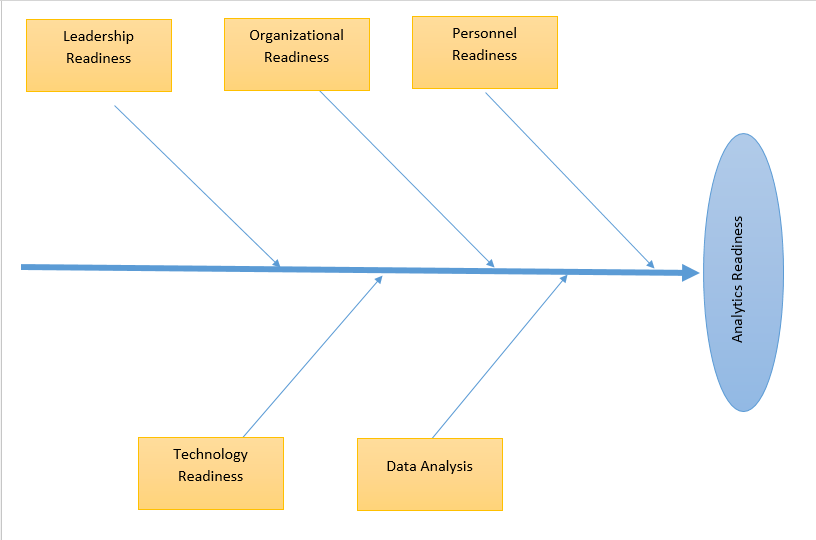
Based on the information we got from the secondary data and questionnaire we created this frame work to assess the readiness capacity of M-Company company to Tahawul project and focus on the gap that faced through it.
Leadership readiness
- Do leaders have sufficient experience in driving change?
- Do leaders have good relationship with key department leaders?
- Do leaders possess exceptional critical thinking skills?
- Do leasers adept at articulating the vision?
Organizational readiness
- Is the organization ready for change?
- Have you identified your change needs?
- Have you identified sources of (quick wins)?
Personnel readiness
- Does the organization have, or can acquire, the right talent?
- Is the staff trained to handle/cope up with change?
Technology readiness
- Is the data needed included in the data warehouse?
- Have you identified the right tools and technology needed?
Data readiness
- Are good data capture processes in place?
- What are the data quality risks?
- Is there familiarity with using data?
Operational and Conceptual of Variables
This section illustrates the conceptual and operational definitions of the variables of the research. Operational definition is a mathematical or scientific analysis of a process or operation, used in making decisions. While conceptual definition is description of a concept by relating it to other concept.
Survey Analysis
This part presents the result of the data collection from the respondents of the questionnaire. These results are based on the respondents that were accessible for the research, this might not be the result for the organization but based upon the respondents, the result and recommendation will be shared.
Variables Scale
Table 2 below represents the scale of employees’ response to each variable in the survey toward need of change.
Result
As illustrated by the above table and following the scale to employee response (1-5), we arrive at the below conclusions:
- The sample of staffs’ responded to the “involvement variable” was “disagree”, which indicates that they weren’t sufficiently involved in the transformation.
- The sample of staffs’ responded to the “communication variable” was “strongly disagree”, which shows that the related communication wasn’t effective.
- The sample of staffs’ responded to the “trust variable” was “neutral”, which doesn’t indicate a relevant problem.
- The sample of staffs’ responded to the “change needed?” was “strongly disagree”, which implies that they did not see any need for change.
Transformation Plan
KSA telecom industry is changing rapidly forcing the Mobile Network Operators to rethink their strategic direction. M-Company management has assessed various opportunities and decided that they need to become an integrated ICT player to compete in the dynamic market and continue its spectacular performance. Becoming an ICT player involves offering new innovative services which require changes across the board. M-Company called this transformation change process ‘Tahawul’ – the corporate transformation, which involves transformation across the organization.
To begin with “Tahawul” process, let’s review the change equation:
{Dissatisfaction * Model * Process}
Model
We created a GAB analysis to know the current position of the company and to be clear what the outcomes are.
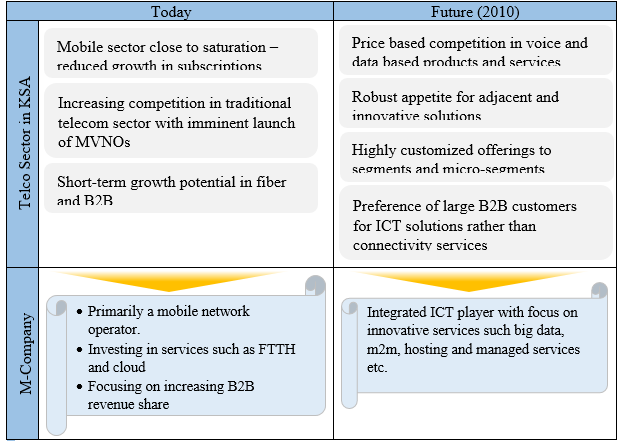
M-Company’s 2020 vision is to become an integrated ICT player with focus on innovative products and services and best-in-class capability across the organization to ensure flawless delivery to customers. The corporate transformation program to realise this vision will impact the organization processes, systems, customers, culture and identity. M-Company need to be ready for these changes!
Process
From this perspective M-Company need a good change management to handle this transformational change in the organization successfully. It is a huge transformation that will affect all M-Company units.
The following Graph created by us based on the secondary data to clarify M-Company’s different units, that affected by the transformation project.
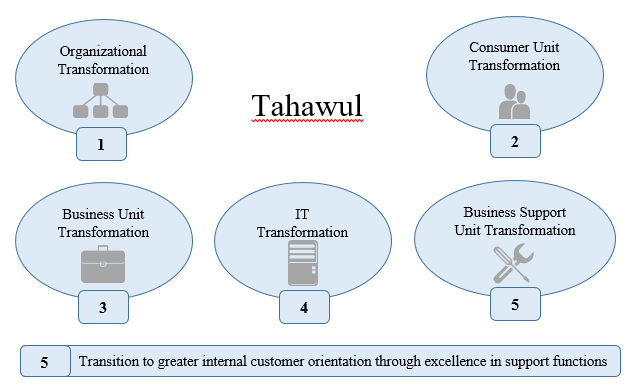
“Tahawul” is expected to have significant impact on M-Company across multiple dimensions: Revenue & Margin, Customer Centricity, Human Capital Development, Efficiency, Brand Positioning, Capabilities Development, Capacity & Reach
Most change initiatives fail to meet their goals, the cost of failed projects is $80 – $145 billion annually. Change plans Started but never completed, completed but under-delivered, behind schedule, and over budget. There are only 16% consistently meet scheduled due dates and more than 70% of all projects are canceled or have major problems before completion. One of the major reasons for change failure in the organizations is people readiness and engagement in the change plan, and from the previous analysis in our research results shows weakness in the dissatisfaction part which is showing clearly by M-Company not creating the need for change among the employees in a proper way.
Recommendation
Successful People engagement
We suggest a model for engaging all employees levels at the transformation project successfully
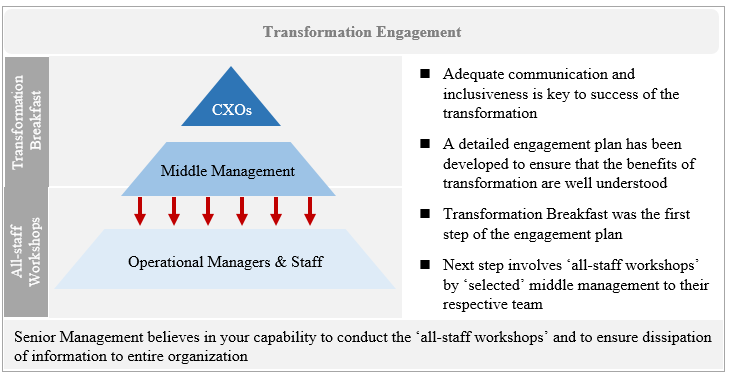
Employee resistance can be active or passive. It can be observable or discreet. But regardless of how resistance manifests itself, it erodes the value of the change and creates additional barriers and work for the project team. Some resistance comes from poorly managing the change, but some resistance is “good resistance” and represents an informed disagreement with the solution or direction of the project. This type of resistance is important to understand and an important input for project teams, but if we do not engage employees and encourage their participation, we are never able to surface this “good resistance” or separate it out from other resistance. Here is a proposed people engagement plan regarding “Tahawul” transformation through M-Company:
Clarify the need to do the transformation process “Tahawul”
Transformation is not outside of the business; transformation is a part of the business to be ready to tackle the competition. The telecommunication market has steadily become more and more competitive – and this trend will continue in the future. Under these circumstances, M-Company must look towards the future and the next evolutionary step for the company.
Strong management of change
To ensure that people are ready for change, and actively involving the people affected by the changes. It will be also a form of risk management to reduce risks caused by resistance.and the main point that a good change management ensures the success of the change process.
To show up the difference between the managed and unmanaged change we create the following model.
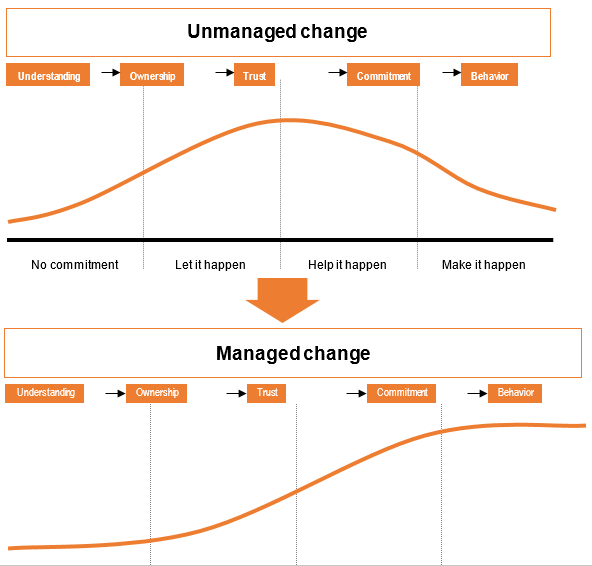
Communication
Communication approach ensures the Transformation projects’ deliverables are sustainable and deliver their full potential:
- All relevant stakeholders should involve and understand the changes and the impact of the changes
- Clarity and overview has to be created
- Stakeholders’ expectations should be managed
- The changes have to be integrated smoothly into daily work processes
- Credibility for the Transformation should be created andmaintained
- Effective communication1 which means, that the business managers should be the change agents that facilitate information sharing between company employees, is helping employees to let go and leave their comfort zone due to follow changes requirements.
Create change agents network
This network will deal with important tasks:
- Reach key audiences, deliver important messages and ensure all voices are heard.
- Facilitate a two-way information channel.
- Testing messages and strategies.
- Channeling feedback to leadership and project teams.
Recommendations in dealing with the change curve
Any change project goes through the stages suggested by the change curve appears in figure 7.1. How long it stays in each stages, however, depends on the initial time plan versus the situational challenges the project faces. In the case of Tahawul and based on the survey made, M-Company fits the first box (phase 1) where they are still lagging and therefore it is suggested that:
- Extra workshops with the change leaders are set to engage the staff in the management vision making them a part of the planning and doing.
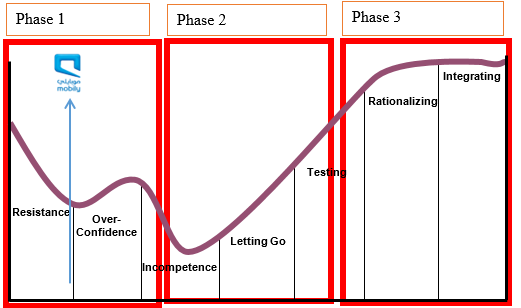
- Allow time for people to digest the changes, Reassure associates that they have valuable skills and encourage them to participate.
- Clarify the purpose, answer questions honestly, paint a picture of how the outcomes will look and feel
- Support a safe environment for changing ways of working, recognize and reinforce positive behaviors, Express the company appreciation for cooperation, Acknowledge successes.
Adjust the time plan
It is suggested to adjust Tahawul’s project plan after the resistance/denial phase is dealt with. The project shouldn’t be expected to finish as planned earlier on the 2020. The time spent from Tahawul started till they reinvent the wheel should be added to the project, promising a new phase of M-Company by 2023.

Distinguish between employee Circle of Concern and Circle of Influence regarding M-Company’s Transformation projects
It is a self-technique, but it is a way of communication that M-Company can follow, because of that we created a graph and rely on it to illustrate this idea
- Circle of Concern encompasses all concerns employee have.
- Circle of Influence encompasses those concerns that M-Company can do something about; they are concerns that M-Company have some control over.
- Two ways of looking at concerns: pro-active and reactive.

Clear about Transformation effect on employees
Transformation will be carried out by each part in M-Company as per guidelines set by the leadership team. Employees should gradually change their way of working to ensure better fit with M-Company’s ICT vision. All employees will need to embrace this change. They will develop new skills, new competencies and will be equipped to deal with the challenges faced by M-Company business. The transformation will create new opportunities for each employee to develop in his career.
But, this change will not happen overnight. There has to be a plan by which different parts of the organization will be touched by transformation at different points of time. The changes in functionalities, responsibilities, processes, etc. will happen over time. Employees have to be informed about the tentative date when the team will undergo transformation, what will be the changes and so on. In the meantime, it is very important that employees continue to contribute towards M-Company’s success and carry on with their day-to-day responsibilities.
Assure that this will “really” work
M-Company can succeed by working together with all the employees towards the common goal. They all have to be willing and eager to bring about this change and must actively work towards it. This means they should not avoid changes because they are too difficult to implement or are too complicated in nature. Other operators have already proven that it is achievable and it brings significant tangible results and there is no reason to believe that M-Company cannot do the same.
At the end, the success of transformation depends on people and is a reflection of how dedicated they are to M-Company’s future, Change is coming and it is for the better.It is important to adopt a “transformation-based” way of thinking like, Openness to new ways of doing things, Exciting changes in their day-to-day work, Change will come when it does, organization can’t stop or else M-Company stops! Leadership has to be fully committed to ensure a successful transformation.
Limitation
One of the research’s limitations we faced was determining the current state of M-Company Company that clarify what they achieved and what they does not achieved, which the secondary data did not provided it and we can’t obtain it because it is a part of the confidential documents.
References
Aladwani, A. M. (2001). Change management strategies for successful ERP implementation. Business Process management journal, 7(3), 266-275.
Todnem By, R. (2005). Organisational change management: A critical review. Journal of Change Management, 5(4), 369-380.
Kelman, H. C. (1958). Compliance, identification, and internalization: Three processes of attitude change. Journal of conflict resolution, 51-60.
Musteen, M., Barker, V. L., & Baeten, V. L. (2006). CEO attributes associated with attitude toward change: The direct and moderating effects of CEO tenure. Journal of Business Research, 59(5), 604-612.
Piderit, S. K. (2000). Rethinking resistance and recognizing ambivalence: A multidimensional view of attitudes toward an organizational change. Academy of management review, 25(4), 783-794.
Oreg, S. (2003). Resistance to change: developing an individual differences measure. Journal of applied psychology, 88(4), 680.
Ford, J. D., Ford, L. W., & D’Amelio, A. (2008). Resistance to change: The rest of the story. Academy of management Review, 33(2), 362-377.
Kotter, J. P. (1997). Leading change: why transformation efforts fail. IEEE Engineering Management Review, 25(1), 34-40.
McKinsey (2008) Quarterly survey on organizational transformation.
Hite, C. Randolph (2010) ORGANIZATIONAL TRANSFORMATION – A Framework for Assessing and Improving Enterprise Architecture Management- (Ron Higgins, 2010 Organizational transformation What is it, why do it, and how?).
Kazmi, S. A. Z., & Naaranoja, M. (2015). Innovative Drives Get Fuel from Transformational Leadership’s Pied Pipers’ Effect for Effective Organizational Transformation!. Procedia-Social and Behavioral Sciences, 181, 53-61.
Latham, J. R. (2013). A framework for leading the transformation to performance excellence part I: CEO perspectives on forces, facilitators, and strategic leadership systems. Latham, JR (2013). A framework for leading the transformation to performance excellence part I: CEO perspectives on forces, facilitators, and strategic leadership systems. Quality Management Journal,20(2), 22.
Orlikowski, W. J. (2002). Improvising organizational transformation over time.K. Kamoche, M. eCunha, & J. da Cunha (Eds.), Organizational Improvisation, 185.
Vakola, M., & Nikolaou, I. (2005). Attitudes towards organizational change: What is the role of employees’ stress and commitment?. Employee relations, 27(2), 160-174.
Bradutanu, D. (2015). Resistance to change – a new perspective: A textbook for managers who plan to implement a change. New York, New York, Lulu.
Griffin, R. (2007). Fundamentals of Management. New York, New York, Cengage Learning.
Heinrich, T. (2004). Resistance to Change – Does Age Matter?: Predicting Negative Attitudes Towards Organizational Change. London, Turnshare.
Lines, R. (2004). Influence of participation in strategic change: resistance, organizational commitment and change goal achievement. Journal of Change Management, 4(3), 193-215.
Pieterse, J. H., Caniëls, M.C.J., & Homan, T. (2012). Professional discourses and resistance to change. Journal of Organizational Change Management, 25(6), 798-818.
Raoprasert, T., & Islam, S. M.N. (2010). Designing an Efficient Management System: Modeling of Convergence Factors Exemplified by the Case of Japanese Businesses in Thailand. New York, New York, Australia Springer Science & Business Media.
Footnotes
- A two way information sharing process which involves one party sending a message that is easily understood by the receiving party. Effective communication by business managers facilitates information sharing between company employees and can substantially contribute to its commercial success.